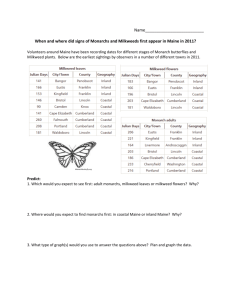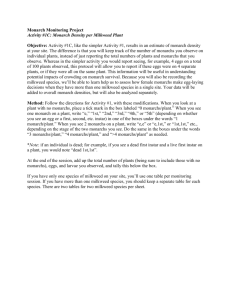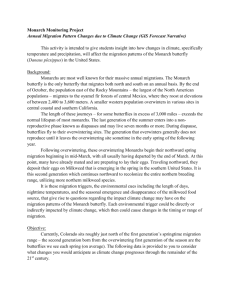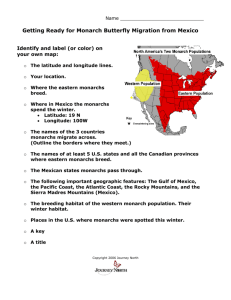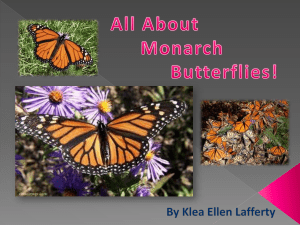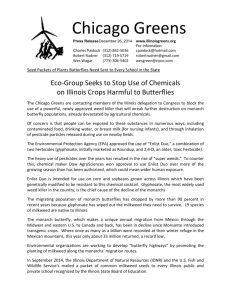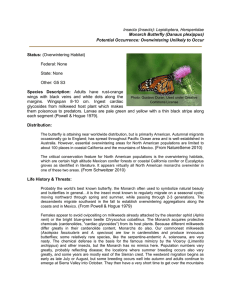A Wandering Monarch in a Milkweed Patch
advertisement
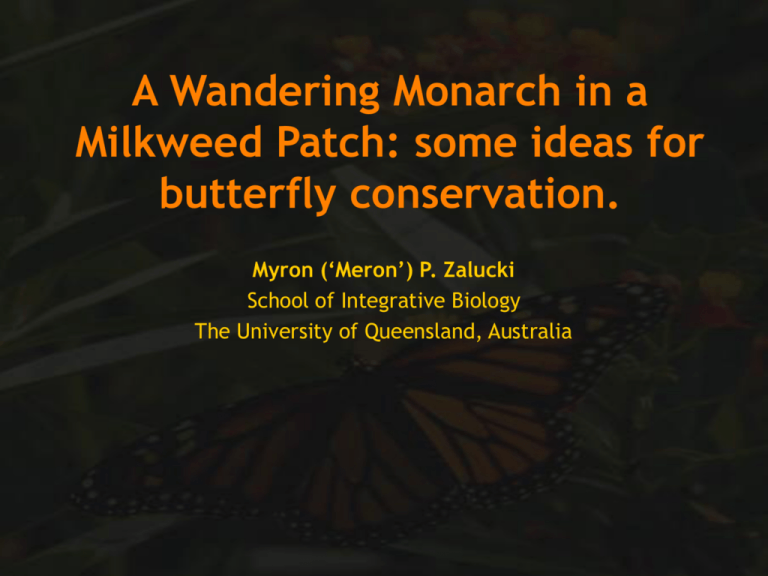
A Wandering Monarch in a Milkweed Patch: some ideas for butterfly conservation. Myron (‘Meron’) P. Zalucki School of Integrative Biology The University of Queensland, Australia Acknowledgments Lincoln Brower, Mike Bull, Tony Clarke, Hugh Dingle, Jane Hughes, Roger Kitching, Duncan Mackay, Steve Malcolm, Tim Paine, Wayne Rochester, Yoshito Suzuki, … and many others Monarchs “down-under” Applied entomology Basic entomology Will monarchs go extinct ? Already an endangered phenomenon! Will Bt corn, climate change, & herbicides impact on monarchs? Climate & changes in abundance Milkweed abundance at a landscape level & host plant search - metapopulations & habitat Modelling risk… What determines large scale fluctuations in monarch abundance? Climate... • Affects milkweed • Affects reproduction & survival • Will have a strong influence on seasonal & year to year abundance & distribution + - D.plexippus D.petilia in North America Year to year variation in climatic suitability Expect large scale variation in abundance… The distribution and abundance of host plant patches will have a dramatic effect on monarch abundance Milkweed Metapopulation of interconnected milkweed patch ‘habitats’ Habitat? Milkweed patch and surrounding ‘highish’ density of single plants defines breeding habitat. Metapopulation of interconnected milkweed patch ‘habitats’ Space between is NOT empty! Rules for egg laying If (‘habitat’) lay all eggs If (‘not habitat’) depends on isolated plants found Monarch Reproduction And that all depends on distribution and abundance of milkweed and the monarchs ability to find these Eggs / female / day 80 60 40 20 0 0 100 200 300 400 500 600 Age in Degree days (dz=11.5 oC) Zalucki. 1981. Res Pop Ecol 23: 318 - 27 What happens as the single plant density (SPD) increases in non-patch areas? SPD = 0.01 Proportion of eggs laid as single plant density (SPD) increases in non-patch areas Search parameter same for patches and singles 1 0.9 0.8 0.7 0.6 0.5 0.4 0.3 0.45 0.2 1 0.4 0.75 0.1 0.5 0 0.35 0.25 0.1 0.25 0.05 0.5 0.75 0.3 0 1 2 4 0.25 0.2 0.15 SPD = 0.1 0.1 1 0.05 0.9 0 0.8 4 0.7 2 0 1 0.6 0.05 0.25 0.75 0.5 0.5 0.75 0.25 0.5 0.1 1 0.4 0.3 0.2 1 0.75 0.1 Change in Proportion eggs laid 0.5 0 0.25 0.1 0.25 0.05 0.5 0.75 0 1 2 4 0.2 0.18 SPD = 0.2 0.16 0.14 1 0.12 0.9 0.8 0.1 0.7 0.08 0.6 0.06 0.5 0.04 0.4 0.02 0 0.3 0.2 1 0.75 0.1 0.5 0 0.25 0.1 0.25 0.05 0.5 0.75 1 0 2 4 4 2 0 1 0.05 0.25 0.75 0.5 0.5 0.75 0.25 0.1 1 Returns on eggs will depend on factors affecting immature monarch survival Zalucki, Clarke & Malcolm Ann Rev Ent 47: 361-393 Earlystage stage monarch survival Early survival & patch size: egg to II instar Patches: 10% Singles: 20% 1 0.75 0.5 Predators? 0.25 0 egg I Stage II Large larval survival: III to V instar Patch plants Single plants 50% 33% Food limitation? Parasitism levels range from 11-80 % in winter/spring to 38-99.9 % in summer/autumn Patch plants 58% Single plants 36% So putting eggs on single plants gives a higher return… Random search for singles 1 0.9 0.8 0.7 0.6 0.5 0.4 0.3 0.2 0.1 1000 0 Population persistence depends very much on ability to find plants both as patches & singles 250 0 0.1 0.25 0.5 0.75 100 1 2 4 Proportion landscape with milkweed patch habitat 1.8 1.6 NRR 1.4 1.2 1 0.8 0.6 0.4 0.2 1000 0 0 250 0.1 0.25 0.5 0.75 1 100 2 4 Density of single plants outside milkweed patch habitat Population viability analysis of migratory monarch butterflies exposed to genetically modified maize Continental-scale resource use migration Malcolm, Cockrell, & Brower, 1993 Primary target of GM Bt-maize is the European corn borer http://www.ent.iastate.edu/pest/cornborer/intro/intro.html Non-target effects of Bt-maize pollen: • Losey, Rayor & Carter, 1999. Nature 399: 214. – Larval mortality increased 44% in greenhouse. • Hansen Jesse & Obrycki. 2000. Oecologia 125: 241248. – 17-20% increase in mortality of larvae exposed in the laboratory to Bt corn pollen deposited naturally on A. syriaca leaves. Risk assessment • Sears et al. 2001 (PNAS 98) measured risk in Iowa as: – R = Pe x Pt • Risk = probability of exposure x probability of toxic effect – For Bt176 pollen: • R = 0.0042 x 0.9 = 0.0038 (0.38%) – For Mon810 and Bt11 pollen: • R = 0.0168 x 0.007 = 0.00012 (0.012%) – At 80% adoption this becomes: • R = 0.067 x 0.007 = 0.00047 (0.047%) • These estimates of R were revised by Dively et al. 2004 (Environ. Entomol. 33) to: – At 37% Bt corn use in Iowa, R = 0.0124 (1.24%) • mortality of 2nd generation in Iowa. – At maximum 80% Bt corn use, R = 0.0261 (2.6%) • Where Pe = proportion monarchs from maize (l) x overlap of pollen shed (o) x adoption rate of Bt maize (a). What does this ‘low’ risk mean for monarch butterflies? – Gi = (Gi-1Ri + iGi-2Ri)SeSlSp • G = generation size. • = proportion overlap varies from 0 to 0.1. • R = average realized fecundity. • S = survivorship of eggs, larvae & pupae. G4 G3 latitude • We use the risk measures for monarch generation 2 of Dively et al. 2004 in a spatially discrete model of 4 linked generations where: G2 G3=Bt G1 spring migration overwintering time autumn migration Stochastic density independent models were run for 100 simulations of 100 years Mexico Mexico 450000000 120000000 400000000 100000000 350000000 80000000 250000000 Mexico 200000000 150000000 Number Number 300000000 60000000 Mexico 40000000 100000000 20000000 50000000 0 0 1 7 13 19 25 31 37 43 49 55 61 67 73 79 85 91 97 Year Model 1 with random normally varying reproduction and no Bt corn effect on survival in G3 with variable generation overlap [R = Pe x Pt = 0.0 x 0.07 = 0.0] mean = 0/500 OW<500,000 (N=100) 1 7 13 19 25 31 37 43 49 55 61 67 73 79 85 91 97 Year Model 1 with random normally varying reproduction and Bt corn effect on survival in G3 and effect on reproduction in G4 with variable generation overlap [R = Pe x Pt = 0.024 x 0.07 = 0.002] mean = 0/500 OW<500,000 (N=100) % extinction at overwintering threshold of 1 million monarchs vs exposure to Bt maize Percentage of simulations in which N fell below threshold 100% Density independent model 1 no no overlap carryover 90% 80% Percentage 70% 60% 50% 40% 30% 20% 10% carryover + 50% 10% overlap + 10% 50% fecundity reduction 0% 0 0.05 0.1 0.15 0.2 0.25 Pe (Proportion exposed to Bt) in DI Random 1 Percentage of simulations in which N fell below theshold Density dependent model 4 90% nooverlap carryover no 80% Percentage 70% 60% 50% 40% 30% 20% 10% overlap carryover++50% 50% fecundity reduction 10% fecundity reduction 10% 0% 0 0.05 0.1 0.15 Pe (Proportion exposed to Bt) in DD Random 4 0.2 0.25 Will monarchs go extinct? • During the 2004/5 winter monarch overwintering populations were the lowest recorded at 2.1 ha of overwintering forest in Mexico. – 10% of the largest recorded area of 21 ha in 1996/97. Overwintering colony areas (hectares) (redrawn from Rendon and Galindo-Leal, 2005) 22 Number of hectares 20 18 16 14 12 10 8 6 4 2 0 93-94 94-95 95-96 96-97 97-98 98-99 99-00 00-01 Overwintering season 01-02 02-03 03-04 04-05 Will monarchs go extinct? • The conclusion of Sears et al. 2001 and Dively et al. 2004 that Bt maize poses low risk to monarchs is premature. • Require more spatially and temporally relevant life-history data before reaching a conclusion. Will monarchs go extinct? • Need to determine the impact of added mortality from GM crops on the population dynamics of monarchs. • A range of simulations suggests that the impact of Bt maize is not trivial. • We also propose to address the impact of herbicide-tolerant soya beans. Will monarchs go extinct ? Don’t know … will depend in part on climate & host plant distribution across the Landscape & risks For this wanderer in a milkweed patch

